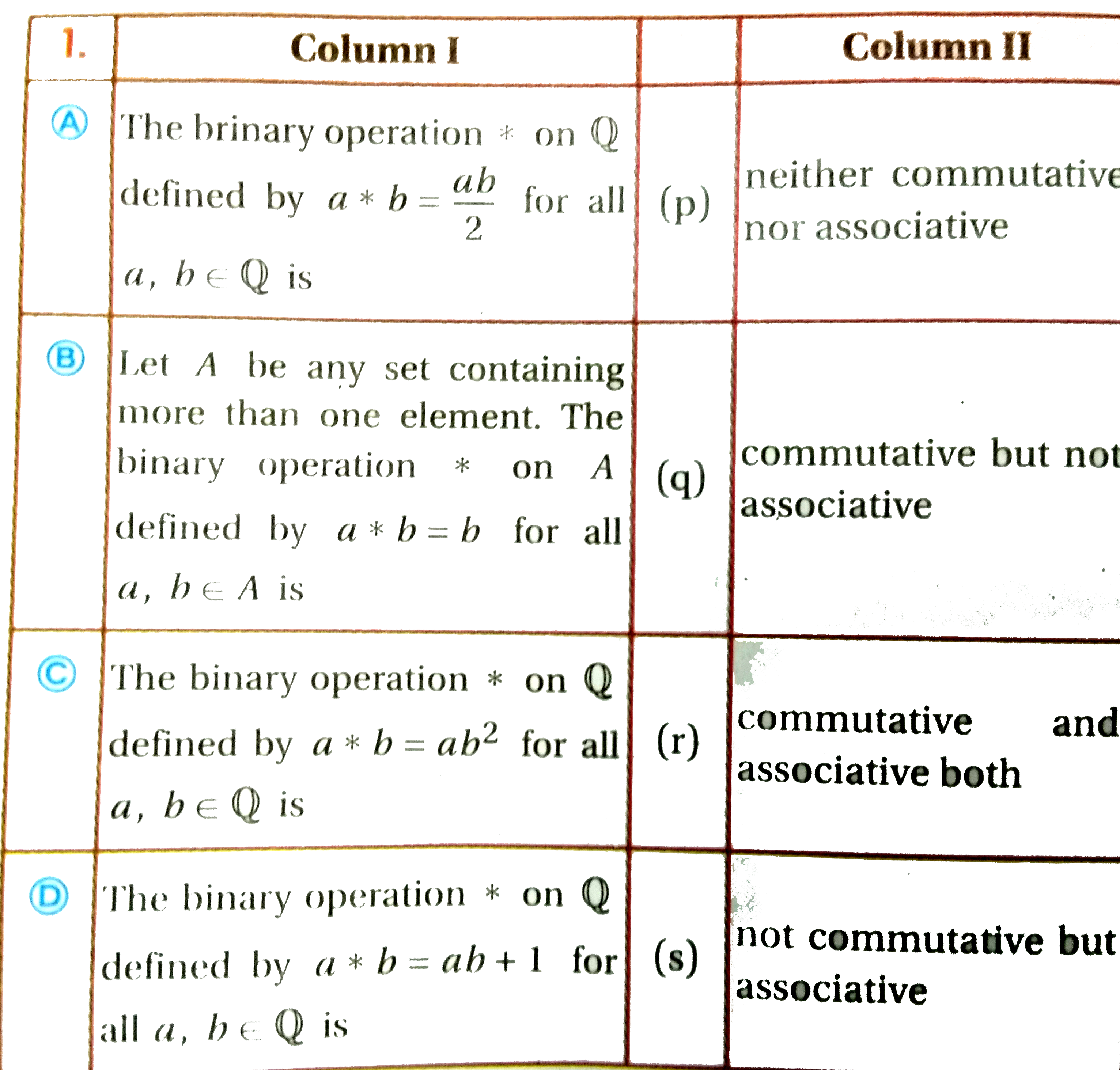Consider the binary operations ∗:R×R→Rand∘:R×R→R defined as a∗b=|a−b|anda∘b=a for all a,b∈R then-Solution in Bengali
∗ is commutative but not associative on R
∘ is associative on R.
∘ is not distribution over ∗
∘ is commutative on R
The correct Answer is:A,B,C
Step by step video, text & image solution for Consider the binary operations **:RRxxRRtoRRand@:RRxxRRtoRR defined as a**b=|a-b|anda@b=a for all a,binRR then- by Maths experts to help you in doubts & scoring excellent marks in Class 12 exams.
Topper's Solved these Questions
- BOOK - CHHAYA PUBLICATIONCHAPTER - BINARY OPERATIONEXERCISE - Integar Answer Type5videos
BINARY OPERATION
- BOOK - CHHAYA PUBLICATIONCHAPTER - BINARY OPERATIONEXERCISE - Matrix Match Type2videos
BINARY OPERATION
- BOOK - CHHAYA PUBLICATIONCHAPTER - BINARY OPERATIONEXERCISE - EXERCISE 3 (Long Answer Type Questions)22videos
BINARY OPERATION
- BOOK - CHHAYA PUBLICATIONCHAPTER - ARCHIVEEXERCISE - JEE Advanced Archive13videos
ARCHIVE
- BOOK - CHHAYA PUBLICATIONCHAPTER - BINOMIAL DISTRUTIONEXERCISE - ASSERTION-REASON TYPE2videos
BINOMIAL DISTRUTION
Similar Questions
Let S={a,b,c}, the total number of binary operations on S be K9. Find the value of K.
03:22View SolutionMatch the following Column I and Column II
 03:39View Solution
03:39View SolutionA binary operation ∘ is defined on R−{−1} by a∘b=a+b+ab for all a,b∈R−{−1}.
(i) Discuss the commutativity and associativity of ∘ on R−{−1}.
Find the identity element, if exists.
(iii) Prove that every element of R−{−1} is invertible.08:28View SolutionFour persons independently solve a certain problem correctly with probabilities,12,34,14,18 Then the probability that problem is solved correctly by at least one of them is-
02:22View SolutionStatement-I: Under some condition in the random experiment, p and q are the probability of 'success' and probability of 'failure' respectively, then the probability for x success is f(x)=nCxpxqn−x(x=0,1,2,......,n)
Statement-II: Sample space of a random experiment has only two sample points one is success and other is failure.02:19View Solutionlet ∗ be a binary operation on R, the set of real numbers, defined by a∘b=√a2+b2 for all a,b∈R. Prove that the binary operation ∘ is commutative as well as associative.
02:18View SolutionProve that the binary operation ∗ on R defined by
a∗b=a+b+ab for all a,b∈R
is commutative and associative.02:23View SolutionLet ∗ and ∘ be two binary operations on R defined as,
a∗b=|a−b|anda∘b=a for all a,b∈R.
Examine the commutativity and associativity of ∗ and ∘ on R. Show also that ∗ is distributative over ∘ but ∘ is not distributive over ∗.02:49View SolutionLet ∘ be an operation defined on R. The set of real numbers, by a∘b=min(a,b) for all a,b∈R. Show that ∘ is a binary operation on R.
04:26View SolutionAn operation ∗ is defined on the set of real numbers R by a∗b=ab+5 for all a,b∈R. Is ∗ a binary operation on R?.
05:38View SolutionShow that an operation ∗ on R, the set of real numbers, defined by a∗b=3ab+√2, for all a,b∈R. Is a binary operaion on R.
03:17View SolutionProve that the operation ∗ on Z defined by a∗b=a|b| for all a,b∈Z is a binary operation
03:40View SolutionProve that the identity element of the binary opeartion ∗ on R defined by a∗b= min. (a,b) for all a,b∈R, does not exist.
01:44View SolutionThe binary operation * define on N by a*b = a+b+ab for all a,b∈N is
02:14View SolutionDetermine which of the following binary operations are associative and which are commutative:
(i) ∗ on R defined by a∗b=1 for all a,b∈R.
(ii) ∗ on R defined by a∗b=a+b2 for all a,b∈R.05:41View Solution

